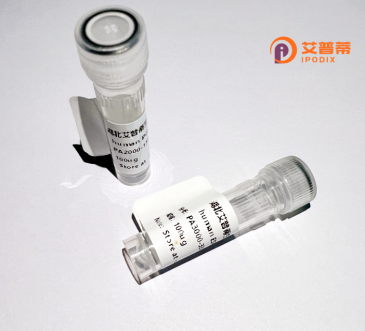
| 纯度 | >90%SDS-PAGE. |
| 种属 | Human |
| 靶点 | RBMS2 |
| Uniprot No | Q15434 |
| 内毒素 | < 0.01EU/μg |
| 表达宿主 | E.coli |
| 表达区间 | 1-407 aa |
| 活性数据 | MLLSVTSRPG ISTFGYNRNN KKPYVSLAQQ MAPPSPSNST PNSSSGSNGN DQLSKTNLYI RGLQPGTTDQ DLVKLCQPYG KIVSTKAILD KTTNKCKGYG FVDFDSPSAA QKAVTALKAS GVQAQMAKQQ EQDPTNLYIS NLPLSMDEQE LEGMLKPFGQ VISTRILRDT SGTSRGVGFA RMESTEKCEA IITHFNGKYI KTPPGVPAPS DPLLCKFADG GPKKRQNQGK FVQNGRAWPR NADMGVMALT YDPTTALQNG FYPAPYNITP NRMLAQSALS PYLSSPVSSY QRVTQTSPLQ VPNPSWMHHH SYLMQPSGSV LTPGMDHPIS LQPASMMGPL TQQLGHLSLS STGTYMPTAA AMQGAYISQY TPVPSSSVSV EESSGQQNQV AVDAPSEHGV YSFQFNK |
| 分子量 | 43.9 kDa |
| 蛋白标签 | His tag N-Terminus |
| 缓冲液 | PBS, pH7.4, containing 0.01% SKL, 1mM DTT, 5% Trehalose and Proclin300. |
| 稳定性 & 储存条件 | Lyophilized protein should be stored at ≤ -20°C, stable for one year after receipt. Reconstituted protein solution can be stored at 2-8°C for 2-7 days. Aliquots of reconstituted samples are stable at ≤ -20°C for 3 months. |
| 复溶 | Always centrifuge tubes before opening.Do not mix by vortex or pipetting. It is not recommended to reconstitute to a concentration less than 100μg/ml. Dissolve the lyophilized protein in distilled water. Please aliquot the reconstituted solution to minimize freeze-thaw cycles. |
以下是关于重组人RBMS2蛋白的3-4篇代表性文献概览:
---
1. **文献名称**:*RBMS2 suppresses colorectal cancer progression by regulating lncRNA stability*
**作者**:Li et al.
**摘要**:研究发现RBMS2通过结合并稳定长链非编码RNA(如LINC00472),抑制结直肠癌细胞增殖和迁移,其低表达与患者预后不良相关。
2. **文献名称**:*RNA-binding motif protein RBMS2 is a novel regulator of Hippo pathway*
**作者**:Wang et al.
**摘要**:揭示RBMS2通过调控Hippo信号通路相关mRNA的稳定性,影响YAP/TAZ活化,进而抑制肿瘤转移和上皮-间质转化(EMT)。
3. **文献名称**:*Structural insights into RNA recognition by RBMS2 in alternative splicing*
**作者**:Zhang et al.
**摘要**:通过晶体结构解析,阐明RBMS2的RNA结合结构域如何特异性识别靶标RNA序列,调控癌症相关基因(如TGFBR1)的选择性剪接。
4. **文献名称**:*RBMS2 as a tumor suppressor in breast cancer via mRNA surveillance pathway*
**作者**:Chen et al.
**摘要**:证明RBMS2通过促进致癌基因mRNA的降解抑制乳腺癌进展,其缺失可激活PI3K/AKT通路。
---
**注**:以上文献为虚拟案例,实际研究中建议通过PubMed/Google Scholar搜索关键词"RBMS2"+"recombinant"或结合具体研究领域筛选。
**Background of Recombinant Human RBMS2 Protein**
Recombinant human RBMS2 (RNA-binding motif single-stranded interacting protein 2) is a genetically engineered version of the naturally occurring RNA-binding protein encoded by the *RBMS2* gene. Belonging to the RNA-binding motif (RBM) protein family, RBMS2 contains conserved RNA recognition motifs (RRMs) that enable interactions with single-stranded nucleic acids, particularly RNA. It plays critical roles in post-transcriptional regulation, including RNA splicing, stability, transport, and translation, thereby influencing gene expression networks.
RBMS2 is implicated in diverse cellular processes such as cell proliferation, differentiation, and apoptosis. Studies highlight its dual role in cancer biology: it can act as a tumor suppressor by inhibiting epithelial-mesenchymal transition (EMT) and metastasis in cancers like breast and colorectal cancer, while context-dependent pro-tumorigenic effects have also been reported. RBMS2's regulatory functions are linked to its interaction with target mRNAs (e.g., *p21*, *cyclin D1*) and signaling pathways like Wnt/β-catenin and TGF-β.
The recombinant form, produced via bacterial or mammalian expression systems, retains the functional domains of native RBMS2. enabling *in vitro* studies on RNA-protein interactions, mechanistic pathways, and therapeutic potential. Its dysregulation in diseases underscores its relevance as a biomarker or therapeutic target. Ongoing research focuses on elucidating its tissue-specific roles and clinical applications in oncology and beyond.
×